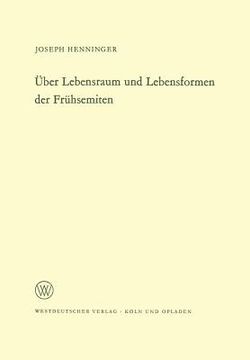Compartir
Über Lebensraum Und Lebensformen Der Frühsemiten (en Alemán)
Joseph Henninger
(Autor)
·
Vs Verlag Fur Sozialwissenschaften
· Tapa Blanda
Über Lebensraum Und Lebensformen Der Frühsemiten (en Alemán) - Henninger, Joseph
S/ 290,55
S/ 581,09
Ahorras: S/ 290,55
Elige la lista en la que quieres agregar tu producto o crea una nueva lista
✓ Producto agregado correctamente a la lista de deseos.
Ir a Mis Listas
Origen: Estados Unidos
(Costos de importación incluídos en el precio)
Se enviará desde nuestra bodega entre el
Martes 23 de Julio y el
Martes 06 de Agosto.
Lo recibirás en cualquier lugar de Perú entre 2 y 5 días hábiles luego del envío.
Reseña del libro "Über Lebensraum Und Lebensformen Der Frühsemiten (en Alemán)"
The name "Semites", which was coined in 1781 by A. L. Schlözer with reference to the so-called "tabie of nations" (Genesis, Chap. X), stands in itself for a linguistic unit only. Whether there was a cultural as well as a racial unit originally corresponding to this linguistic unit is a problem of its own. For more than a century various theories have been evolved as to the geographic area in which the group of people speaking the hypothetical Semitic, respectively "Hamito-Semitic" common language was living: Ara- bia, Mesopotamia, areas situated more to the north-east or north-west, North Africa. The question of the geographical area is closely connected with the way of life of the first Semites. The hypothesis that it resembied the way of life of the Arabian Bedouins (a civilization of bellicose camel- breeders) has no longer been tenable since it became certain that they represent a relatively recent form of nomadism. At what period camel- breeding started is also a much-disputed question. It is true that the domes- ticised one-humped camel can perhaps be traeed back as far as to the end of the fourth millennium, certainly to the third and second millennium B. C. But only towards the end of the second millennium B. C. can camel-breed- ing be considered as the actual economie basis and as determining the way of life. In the beginning and in the middle of the second millennium B. C. the Semitic nomads were breeding small cattle and donkeys.
- 0% (0)
- 0% (0)
- 0% (0)
- 0% (0)
- 0% (0)
Todos los libros de nuestro catálogo son Originales.
El libro está escrito en Alemán.
La encuadernación de esta edición es Tapa Blanda.
✓ Producto agregado correctamente al carro, Ir a Pagar.

